Analysis
The Market for Fischli and Weiss Doesn’t Reflect the Artists’ Star Status
The duo is undervalued but not under-appreciated.
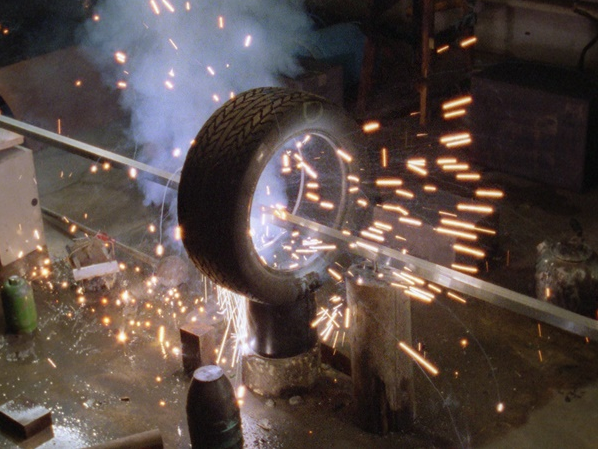
The duo is undervalued but not under-appreciated.

Eileen Kinsella

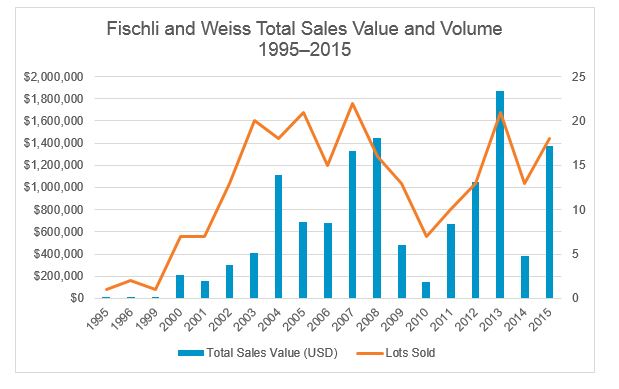
Source: artnet Analytics.
The star Swiss art duo Peter Fischli and David Weiss are definitely having an art world moment, which is not surprising considering their more than three-decade-long career, and global reach. But their auction prices have yet to reflect this status.
A long-awaited retrospective at the Solomon R. Guggenheim Museum, that was in the planning stages even before Weiss’s untimely death in 2012 at age 65, is the first-ever major show of their work at a New York museum, and the first survey of their joint production in the US since 1997.
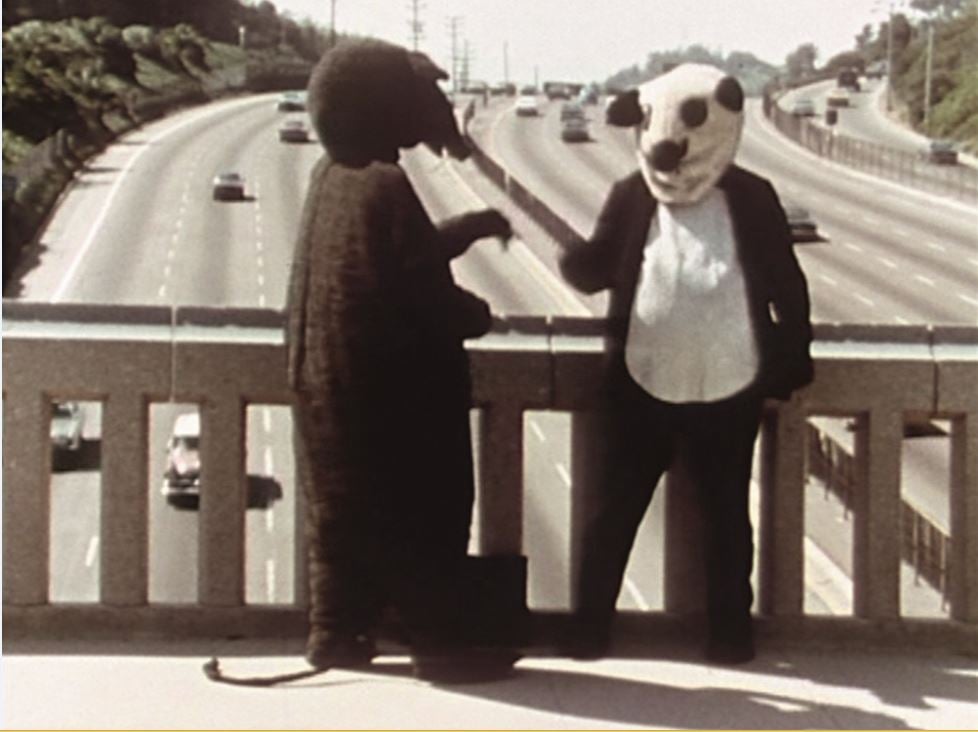
Peter Fischli and David Weiss, The Least Resistance (1980–81)
Color video transferred from Super 8 film, with sound, 29 min.
© Peter Fischli and David Weiss.
Image: Courtesy the artists and Guggenheim Museum.
The exhibit, titled “How to Work Better” (February 5–April 27), has been drawing crowds and garnering rave reviews from critics, following the Guggenheim’s stamp of approval. In the catalogue introduction, Guggenheim director Richard Armstrong called the artists “contemporary alchemists” adding that their work is “a deceptively casual meditation on how we perceive everyday life…that is exceptionally fresh.” Chief curator Nancy Spector (who has since left the Guggenheim for the Brooklyn Museum), refers to their art as “a slow burn.”
The artists, who are often simply referred to as “Fischli/Weiss,” are known for their wit and playfulness as they mine everyday life for inspiration. Their wide-ranging practice encompasses photography, film (including their wild experiments with Rube Goldberg-like contraptions, and role-play as a rat and a panda bear), clay, resin, and rubber sculptures, cured meats, found objects, and sprawling mixed-media installations.
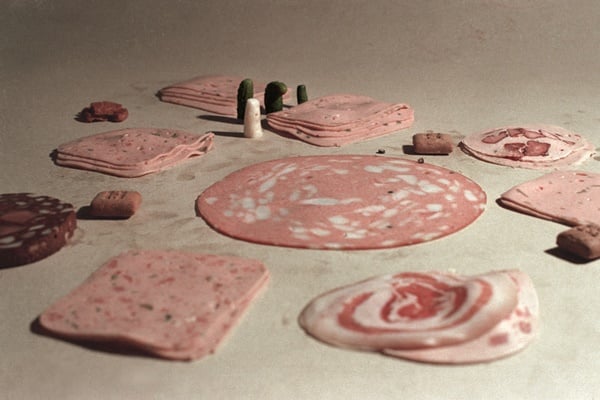
Peter Fischli and David Weiss At the Carpet Shop (from Sausage Series) (1979)
Walker Art Center, Minneapolis, Clinton and Della Walker Acquisition Fund, 1993
© 2015, Peter Fischli and David Weiss.
Image: Courtesy of the artists and Guggenheim Museum.
The artists’ subtle yet humorous investigation into the mundane has made them a favorite of curators and collectors worldwide, including tastemaker Hans Ulrich Obrist. But their secondary market seems subdued in comparison.
“I think it might have to do with the fact that really large or important works don’t come up very often,” said Jean Paul Engelen, Phillips’ worldwide head of contemporary art, in a phone interview with artnet News. Instead, “there is a lot of smaller, editioned works that come up regularly. It might have to do with how their body of work is built up.” He notes that their rubber sculptures from the 1980s are “very much sought after,” and that price levels vary widely in their site-specific commissions.
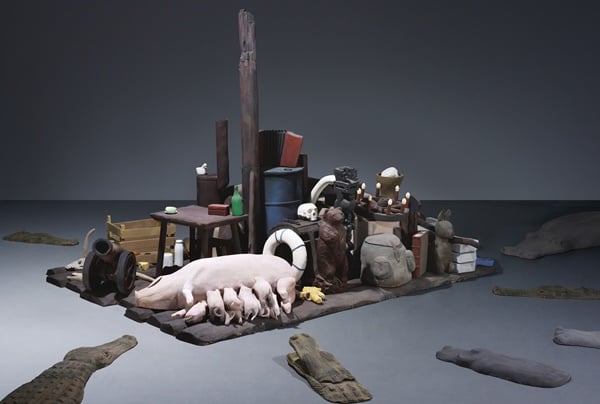
Peter Fischli and David Weiss, Floß, (1982-83) sold at Phillips London in October 2013 for $960,000 (£602,500) and remains the current record auction price.
Image: Courtesy of Phillips.
The artnet Price database lists 324 results for the art duo. Of these, 76—23 percent—are listed as “bought in” aka unsold. The lowest price on record is $184, for an offset print sold at auction in Germany in 2001.
The highest price is about $960,000 (£602,000) for Floß (1982-83) comprised of 72 pieces of painted polyurethane foam (pictured above). The work is on view at the Guggenheim show, in its own room on the top floor of the museum.
Perhaps tellingly, the second-highest price even approaching that was achieved eight years ago, at Christie’s sale of “Swiss Art,” in Zurich in December 2008. Der Lauf der Dinge (1997) is a mixed media assemblage in a glass vitrine that sold for $843,000 (CHF 1,023,000) on an estimate of $741,000 to $1.2 million. These are the only two works that have sold at auction for more than $500,000.
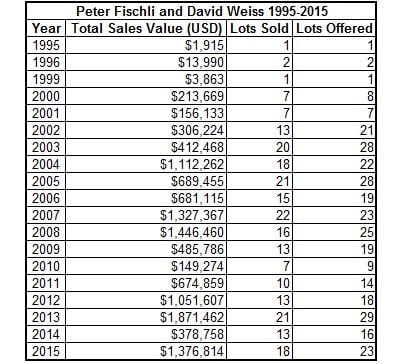
Source: artnet Analytics.
“I think what you can say about Fischli and Weiss is that they’re not really there yet in terms of prices,” said René Lahn, international director of postwar and contemporary art at Christie’s. “They’re not where you think they should be at that kind of level of artistic production.”
Lahn adds: “I believe the Guggenheim show is going to introduce Fischli and Weiss on a bigger scale to US collectors and the scene in general and I think that will have an impact.”
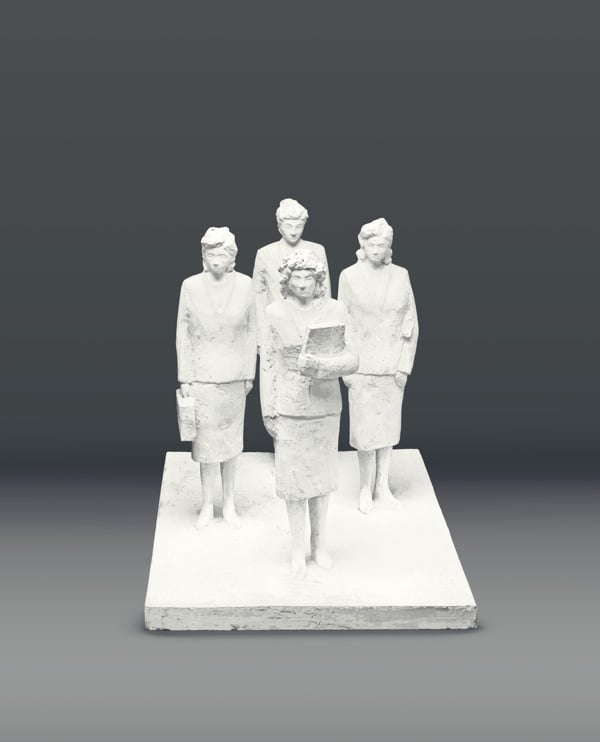
Peter Fischli and David Weiss, Hostessen (1989)
Image: Courtesy of Christie’s.
The top of the auction price list is heavy with their white resin sculptures, many of airline stewardess, such as Hostessen (1989) which depicts four standing figures on a platform. It sold at Christie’s New York this past May for $473,000 (estimate: $300–400,000).
In total, just ten of Fischli/Weiss’s works have sold above $200,000 each.
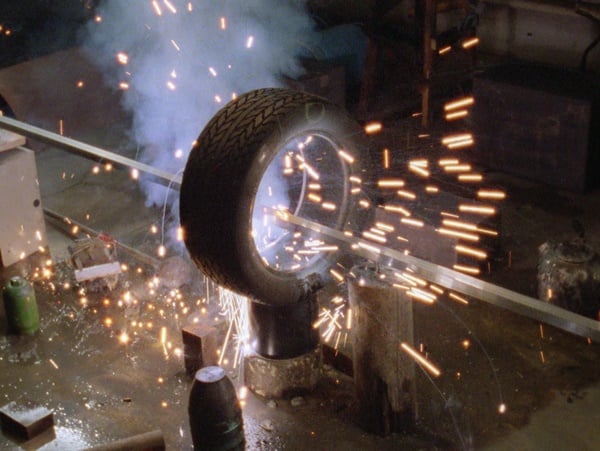
Peter Fischli and David Weiss The Way Things Go (1987)
Color video, transferred from 16 mm color film, with sound, 30 min.
Solomon R. Guggenheim Museum, New York, Gift, Matthew Marks 2015.18.3
© Peter Fischli and David Weiss Image:Courtesy of the artists and Guggenheim Museum.
“The works were always well known and sought after by European institutions and collectors,” echoes Stephanie Dorsey, a senior director at Matthew Marks Gallery, which represents Fischli/Weiss in the US. “Interest has increased over the years, first with institutions, then with collectors and even more so since the Guggenheim show.”
Dorsey said: “The Polyurethane Objetcs are the most sought after. They haven’t come up very often and when they have, they’ve sold really well.” She added that the gallery’s sales of their work are “stable and consistent.”
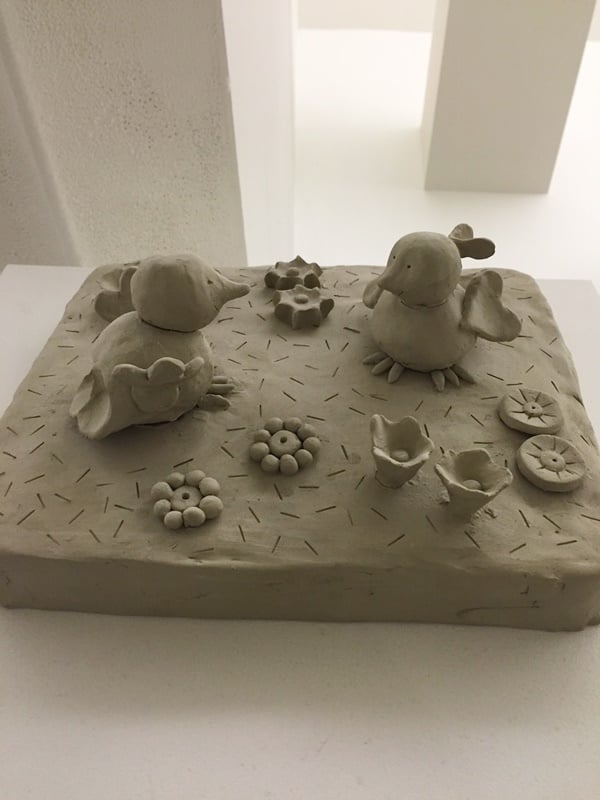
Peter Fischli and David Weiss, Bibeli and Bobeli in Spring, one of dozens of unfired clay sculptures at the Guggenheim show.
Photo by Eileen Kinsella
Zurich gallerist Eva Presenhuber, the longtime representative for the artists in Europe, told artnet News via email: “Fischli Weiss are not collected by speculators and the work is mostly sold through primary market dealers.”
Presenhuber says their work is collected by many European institutions and collectors “who believe in the long life of art rather than the short life of the recent auction market.” She continues:
“We have top collectors here [who] started to collect Fischli Weiss 30 years ago and still continue. It is a fact that every significant private collection in Europe collects Fischli /Weiss. All major museums in Switzerland as well as in Europe who collect contemporary art have Fischli/Weiss in their collection. In the US and Mexico they are collected mainly by museums and collections which are public.”
But the duo’s public art commissions are still growing. Rock On Top of Another Rock (2013), a sculpture outside the Serpentine Gallery, was the first public sculpture by the artists to be commissioned in the UK.
In the US, two public works by the artists are timed to run with the Guggenheim show: Public Art Fund (February 5–May 1) is presenting the text-based monument to labor, How to Work Better (1991), as a wall mural at the corner of Houston and Mott Streets; and throughout February, nightly at 11:57 pm, their charming video Büsi (Kitty) (2001), showing a cat lapping up milk, appeared in Times Square as part of Times Square Arts’ Midnight Moment program.